The Queen’s clock, part 4, restoration.
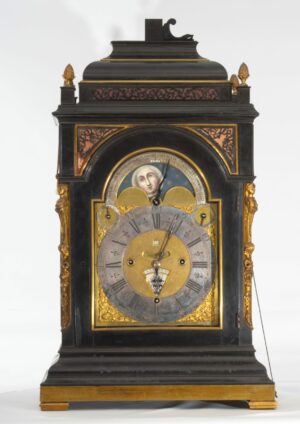
A large and rare Dutch musical table clock from the Dutch Royal collection.
Collection of Queen Juliana
Gude & Meis recently acquired a Dutch table clock which was sold at Sotheby’s Amsterdam in March 2011. The sale consisted of art and objects from the collection of Queen Juliana of The Netherlands. We thought that it would be interesting to share the history, characteristics and restoration of this clock with you in a series of short articles.
Update
Following our earlier posts about the former whereabouts of the clock and some explanation on dating table clock we now have to wait. Our restorers our quite busy bringing the clock back to its former glory. And there is good news; the work on the clock case has finished. Therefore we thought it nice to show you the original state and the final result.
An untouched clock

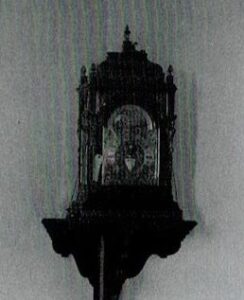
Looking carefully at the old pictures we can see that there were already quite a few defects in the clock. The best visible of these defects being the small curl next to the finial on top of the clock. But besides this there are pieces of molding and fretwork that are either damaged or lacking. On the Sotheby’s picture this curl seems to be there but when we purchased the clock it seemed missing again. Even on the picture from Palace Nooreinde from the 1930’s the clock seems to be damaged while in the living quarters of Queen Wilhelmina. This is quite remarkable when we realize that at that time she was one of the richest women in the world. It also means that the clock was untouched for about hundred years.
The damaged frets
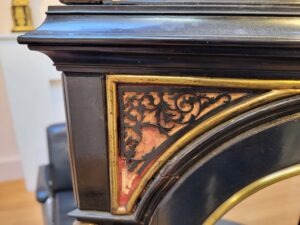

Here we can see the damages to the frets above the door. Looking closely at the picture of 1967 these damages are visible also.
The sides
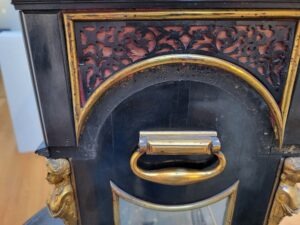
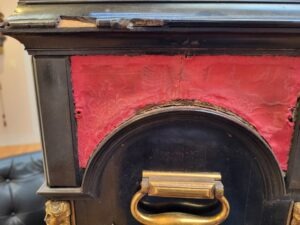
This are pictures from both sides of the case. Not only is the fretwork missing on one side. Also lacking are a semi circular wooden molding and a brass molding.
The ‘bell top’
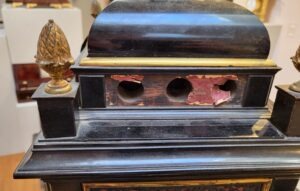
Besides the small curl next to the top finial that was missing there were more defects to the bell top of the case. On one side a piece of fretwork was lacking. The whole top was just standing loose on a strip of fabric showing that this was actually done on purpose. It remains a question why this was done.
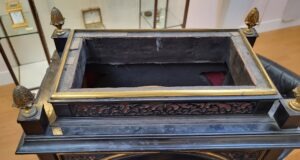

The plinth
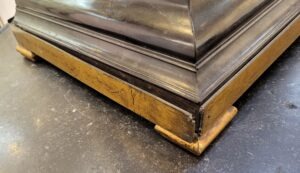
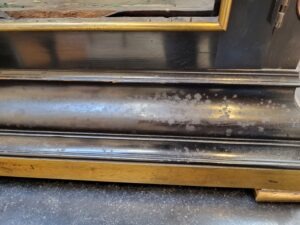
On the pictures of the plinth we can see that part of the brass mounts were loose. However it does show the corner joint nicely. The clock must have been in a damp place at one time with the moisture causing spotting of the black finish.
A pleasant surprise
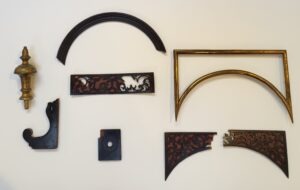
Taking everything into account quite a few parts and pieces seemed to be lacking which meant that these needed to be reconstructed. This is possible but expensive. But we were lucky. As usual the movement is placed on a seatboard which rests on wooden blocks to make sure it is at the right height. This leaves a void below this seatboard that can’t be looked into easily. To our pleasant surprise we found a lot of the missing pieces when we took the movement out of the case. It was probably policy to put parts that came off the clock inside the case for later repair. With this the brass mount and ebony moulding didn’t have to be re-made and the fretwork could be repaired and placed back.
The final result
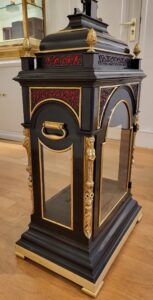

Here is the final result. The loose parts glued back. The fretwork repaired, added and placed back over a ground of new fabric. All brass mounts and parts were cleaned and put back on the case. Finally the black finish was redone making the case look fantastic again! Praise to the restorer!
At this moment the movement and dial are being restored….. To be continued!
